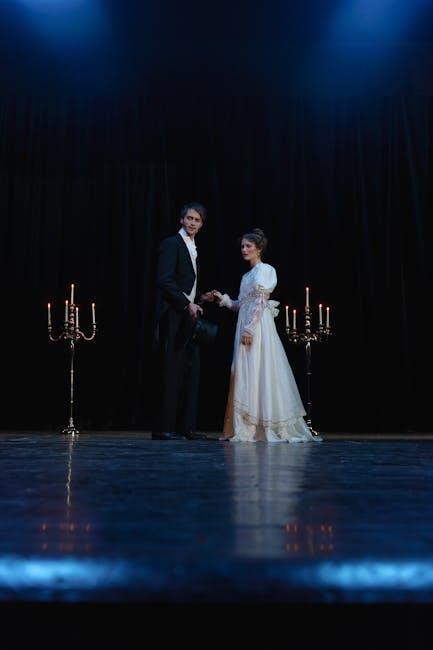The Crucible Act 1: Questions and Answers, A Comprehensive Study Guide
Dive into Act 1 with our detailed guide! Explore key events, characters, and themes using a downloadable PDF study resource.
Uncover insightful questions and answers, enhancing your comprehension of this pivotal opening act.
This comprehensive resource, available as a PDF, will help you navigate the complexities of the play’s beginning,
focusing on critical plot points and character introductions.
Prepare for success with our expertly crafted questions and answers, designed to deepen your understanding of The Crucible.
Arthur Miller’s The Crucible, a powerful dramatization of the Salem witch trials of 1692, serves as a chilling allegory for McCarthyism and the dangers of mass hysteria. Act 1 immediately plunges the audience into a community gripped by fear and suspicion, setting the stage for the tragic events that unfold. The play isn’t merely a historical recounting; it’s a profound exploration of human fallibility, societal pressures, and the devastating consequences of unchecked accusations.
This opening act introduces the core characters – Reverend Parris, his daughter Betty, Abigail Williams, and the enslaved Tituba – and establishes the initial crisis: Betty’s mysterious illness. The atmosphere is thick with religious fervor and repressed desires, creating a breeding ground for paranoia. Miller masterfully uses dialogue and stage directions to reveal the underlying tensions within Salem’s seemingly pious society.

Understanding Act 1 is crucial for grasping the play’s central themes. It lays the foundation for the escalating conflict and foreshadows the tragic fates of many characters. A thorough examination of this act, aided by resources like downloadable PDF study guides, will provide a solid base for interpreting the play’s complex layers and enduring relevance. Preparing with a PDF will help you understand the nuances of the characters and the historical context.
Historical Context of The Salem Witch Trials

The Salem witch trials, occurring in 1692 in colonial Massachusetts, were a dark period fueled by religious extremism, fear, and social anxieties. Triggered by the strange behavior of young women, accusations of witchcraft quickly spiraled out of control, leading to the imprisonment of over 200 people and the execution of twenty. These trials weren’t isolated incidents; similar witch hunts occurred throughout Europe during the 16th and 17th centuries.
Several factors contributed to the hysteria in Salem, including strict Puritan beliefs, political instability, economic hardship, and pre-existing conflicts within the community. The afflicted girls, often seeking attention or expressing repressed emotions, played a pivotal role in initiating and perpetuating the accusations. Spectral evidence – testimony based on dreams and visions – was readily accepted, further exacerbating the situation.
Arthur Miller drew inspiration from these historical events, recognizing parallels between the Salem trials and the anti-communist “Red Scare” of the 1950s. Studying the historical context, perhaps with a helpful PDF guide, is essential for understanding the play’s allegorical significance and appreciating the dangers of unchecked power and mass hysteria. A PDF can provide a deeper understanding of the events that inspired Miller’s masterpiece.
Characters Introduced in Act 1
Act 1 of The Crucible meticulously introduces a cast of characters central to the unfolding drama. Reverend Parris, a concerned and somewhat insecure minister, initiates the play’s conflict with his daughter Betty’s mysterious illness. His daughter, Betty, lies seemingly comatose, fueling the initial fears of witchcraft. Abigail Williams, Parris’s niece, emerges as a manipulative and vengeful figure, quickly becoming a key player.
We also meet Tituba, Parris’s enslaved woman, who is pressured to confess to witchcraft. The Proctor family – John and Elizabeth – are introduced, hinting at a troubled marriage and hidden secrets. Ann and Thomas Putnam, influential and resentful members of the community, contribute to the escalating accusations. Finally, Reverend Hale, an expert in witchcraft, arrives from Beverly, intending to investigate the situation.
Understanding these characters’ initial presentations is crucial for interpreting their motivations and actions throughout the play. A detailed character analysis, often found in a comprehensive PDF study guide, can illuminate their complexities. Exploring Act 1 questions and answers in a PDF format will help you grasp their roles and relationships within the community.
The Opening Scene: Reverend Parris and Betty
The play dramatically opens in Reverend Parris’s meeting house, with a palpable sense of dread and secrecy. Reverend Parris is deeply troubled by the illness of his daughter, Betty, who lies unresponsive with other young girls. He’s intensely concerned about his reputation and fears accusations of witchcraft linked to his family. This initial scene immediately establishes the atmosphere of paranoia and religious fervor that permeates Salem.
Parris’s questioning of Abigail reveals that the girls were engaged in forbidden activities in the woods – dancing and, more disturbingly, conjuring spirits with Tituba. This revelation hints at underlying tensions and repressed desires within the community. The scene’s tension is heightened by the arrival of Putnam, adding to the growing sense of unease and suspicion.
Analyzing this opening scene through Act 1 questions and answers – often available in a detailed PDF – is vital. A PDF study guide can help unpack the symbolism and foreshadowing present, revealing the roots of the impending hysteria. Understanding Parris and Betty’s dynamic sets the stage for the entire play’s conflict;
Abigail Williams: Character Analysis and Motivations
Abigail Williams emerges as a central, and deeply complex, character in The Crucible. In Act 1, she’s presented as a manipulative and vengeful young woman, driven by a potent mix of desire and resentment. Her dismissal from the Proctor household, stemming from an affair with John Proctor, fuels her actions and sets the play’s tragic events in motion.
Abigail’s motivations are rooted in a desperate need for power and control. She seeks to regain Proctor’s affection and will stop at nothing to eliminate Elizabeth, whom she views as an obstacle. Her willingness to lead the other girls in false accusations demonstrates a chilling capacity for deceit and cruelty.
Exploring Act 1 questions and answers – often found within a comprehensive PDF study guide – reveals the nuances of Abigail’s character. A PDF resource can help analyze her dialogue and actions, uncovering the layers of her motivations. Understanding her past and desires is crucial to comprehending the unfolding tragedy.
The Arrival of Reverend Hale
Reverend Hale’s entrance in Act 1 marks a significant turning point, introducing an authority figure ostensibly dedicated to discerning the truth about the alleged witchcraft. He arrives from Beverly, summoned by Reverend Parris, carrying with him a reputation for expertise in detecting demonic influence.
Initially, Hale embodies intellectual confidence and a belief in the validity of spectral evidence. He approaches Salem with a methodical, almost scientific, mindset, intending to employ his knowledge to root out evil. However, his arrival also foreshadows the dangers of unchecked authority and the potential for misjudgment.
Act 1 questions and answers, often detailed in a PDF study guide, focus on Hale’s character and his evolving role. A PDF resource can illuminate his initial intentions and the subtle shifts in his perspective as the act progresses. Analyzing his interactions with the Proctors and the girls is key to understanding his influence on the unfolding events.
His presence escalates the hysteria, despite his initial good intentions.
Tituba’s Confession and the Naming of Names
Tituba’s confession is a pivotal moment in Act 1, fueled by fear and coercion, marking the beginning of the escalating accusations. Under intense pressure from Reverend Hale and the authorities, she initially confesses to consorting with the devil, desperately attempting to save herself from punishment.
Crucially, Tituba begins to name others as accomplices, initially Sarah Good and Sarah Osburn, and then, under further duress, Abigail Williams and Betty Parris. This act of naming, driven by self-preservation, unleashes a wave of accusations that rapidly engulfs Salem.

Crucible Act 1 questions and answers, frequently found in a comprehensive PDF study guide, explore the motivations behind Tituba’s confession and the significance of her naming of names. A PDF resource will detail how this confession establishes a pattern of false accusations and contributes to the growing hysteria.
Analyzing this scene reveals the power dynamics at play and the devastating consequences of succumbing to fear and manipulation.

The Significance of the Poppet
The poppet, a rag doll given to Mary Warren by Abigail Williams, serves as a crucial piece of evidence in Act 1, and a key element in understanding the unfolding hysteria. When Abigail accuses Mary of witchcraft, she claims to have seen Mary sending her spirit out in the form of the poppet to harm her.
This accusation is particularly damning because Elizabeth Proctor is found with a similar poppet, complete with a needle stuck in it. Abigail uses this to falsely accuse Elizabeth of witchcraft, demonstrating her manipulative nature and desire to eliminate Elizabeth as a rival for John Proctor’s affection.
Crucible Act 1 questions and answers, often detailed in a PDF study guide, explore the symbolism of the poppet. A PDF resource will highlight how it represents the power of suggestion, the dangers of false accusations, and the vulnerability of the accused.
The poppet’s significance lies in its ability to materialize suspicion and fuel the escalating paranoia within Salem.
John Proctor’s Relationship with Abigail
The illicit affair between John Proctor and Abigail Williams forms a central conflict in The Crucible, powerfully revealed in Act 1. Their past relationship, a secret Proctor desperately tries to conceal, fuels Abigail’s vengeful actions and drives much of the play’s drama.

Abigail’s continued infatuation with Proctor is evident in her behavior and accusations; She attempts to rekindle the affair, but Proctor firmly rejects her advances, recognizing the moral implications and the threat to his marriage with Elizabeth.
Crucible Act 1 questions and answers, frequently found in a comprehensive PDF study guide, delve into the complexities of this relationship. A PDF resource will analyze Proctor’s guilt, Abigail’s motivations, and the devastating consequences of their past actions.
Understanding this dynamic is crucial for interpreting the play’s themes of guilt, redemption, and the destructive power of repressed desire. The relationship’s impact resonates throughout the entire play.
Elizabeth Proctor: Her Role and Reputation
Elizabeth Proctor embodies integrity and moral fortitude within the tumultuous events of The Crucible. Though absent for much of Act 1, her character is powerfully established through the dialogue surrounding her and John’s strained marriage.
Elizabeth’s reputation for honesty and piety is paramount in Salem society. This makes her a target for Abigail Williams, who seeks to discredit Elizabeth to eliminate her as an obstacle to winning John’s affection.
Crucible Act 1 questions and answers, often detailed in a PDF study guide, explore Elizabeth’s role as a symbol of virtue and the devastating impact of false accusations on her standing within the community. A PDF resource will highlight the importance of reputation in a theocratic society.

Her quiet strength and unwavering principles contrast sharply with the hysteria gripping Salem. Understanding Elizabeth’s character is vital to grasping the play’s central themes of justice and societal hypocrisy.
The Theme of Hysteria in Act 1
Act 1 of The Crucible masterfully introduces the burgeoning theme of hysteria, showcasing how fear and suspicion rapidly consume Salem. The girls’ bizarre behavior in the forest, and Betty Parris’s subsequent illness, ignite a wave of panic fueled by superstition and religious extremism.
Crucible Act 1 questions and answers, frequently found in comprehensive PDF study guides, delve into the origins of this hysteria. The PDF will likely explore how Reverend Parris’s anxieties and the community’s rigid beliefs contribute to the escalating crisis.
Abigail Williams expertly manipulates this atmosphere, exploiting the girls’ fear of punishment to deflect blame and pursue her own vengeful agenda. The accusations begin subtly, but quickly gain momentum, demonstrating the contagious nature of mass hysteria.
Analyzing Act 1 reveals how easily reason and truth can be overshadowed by irrational fear, setting the stage for the tragic events that unfold; Understanding this theme is crucial for interpreting the play’s enduring relevance.
The Role of Authority: Parris and Hale

In Act 1 of The Crucible, the contrasting figures of Reverend Parris and Reverend Hale embody differing approaches to authority, both contributing to the unfolding tragedy. Parris, primarily concerned with his reputation and position, fuels the hysteria through his anxious inquiries and public displays of fear.
Crucible Act 1 questions and answers, often detailed in PDF study guides, highlight Parris’s self-serving motivations. These resources explore how his desire to maintain control overrides his judgment and exacerbates the situation.
Conversely, Reverend Hale arrives as an expert in witchcraft, initially representing rational authority. He seeks to uncover the truth through investigation, but his reliance on spectral evidence and his eventual validation of the court’s proceedings demonstrate a dangerous shift.
The PDF will likely analyze how Hale’s authority, though initially well-intentioned, becomes complicit in the injustice. Both Parris and Hale, in their distinct ways, illustrate the dangers of unchecked power and the fragility of reason in the face of mass hysteria.
Analyzing Key Quotes from Act 1
Act 1 of The Crucible is rich with impactful dialogue, offering crucial insights into character motivations and the play’s central themes. A comprehensive PDF study guide focusing on Crucible Act 1 questions and answers will invariably dissect pivotal quotes.
For instance, Abigail’s line, “I want to live, Good Proctor!” reveals her desperation and willingness to manipulate others. Proctor’s retort, “Give them hell, Reverend,” showcases his defiance and moral complexity.
PDF resources often explore Tituba’s confession, driven by fear and coercion, and the significance of her naming names. These analyses demonstrate how easily truth can be distorted under pressure.

Furthermore, Parris’s pronouncements about the devil’s presence and Hale’s inquiries into spectral evidence are key to understanding the escalating hysteria. Examining these quotes within the context of the play’s historical background, as detailed in many PDF guides, illuminates the dangers of religious extremism and the abuse of power.
Commonly Asked Questions About Act 1 (and Answers)
Students frequently ask: What is the significance of the forest in Act 1? The forest symbolizes freedom and forbidden desires, representing a space outside the strict confines of Salem’s Puritan society. A detailed PDF containing Crucible Act 1 questions and answers will elaborate on this.
Another common question: Why does Reverend Parris seem so concerned with his reputation? Parris is deeply insecure and fears losing his position, driving much of his behavior.
Many wonder about Abigail’s motivations. She seeks power and desires John Proctor, fueling her manipulative actions. PDF study guides often provide character analyses to unpack these complexities.
Is the poppet important? Absolutely! It serves as crucial evidence in the accusations, highlighting the absurdity and danger of spectral evidence. Resources like downloadable PDFs offer in-depth explanations of these symbolic elements.
Finally, students ask about the overall mood of Act 1. It’s one of mounting tension, fear, and suspicion, foreshadowing the tragedy to come.
Resources for Further Study: PDF Downloads & Online Guides
To deepen your understanding of The Crucible Act 1, several excellent resources are available. Begin with a comprehensive PDF study guide containing detailed questions and answers, readily downloadable from various educational websites. These guides often include character analyses, thematic explorations, and insightful commentary.
SparkNotes and CliffNotes offer accessible online summaries and analyses, providing a solid foundation for understanding the play’s complexities. Look for resources specifically focusing on Act 1 to streamline your study process.

Many universities and high schools post lecture notes and study materials online. A quick search for “The Crucible Act 1 resources” will yield a wealth of information.
Consider exploring online forums and discussion boards where students and educators share insights and interpretations. Websites offering PDF versions of the play’s text are also invaluable for close reading and annotation.
Don’t forget to utilize literary databases and academic journals for scholarly articles offering deeper critical perspectives.
